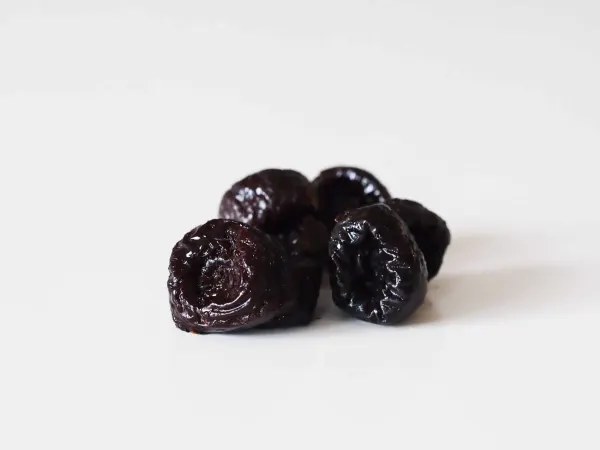Access our First Foods® Database in the Solid Starts App.
Learn morePrune
Fruit
Age Suggestion
6 months
Iron-Rich
No
Common Allergen
No

When can babies have prunes?
Pitted prunes may be introduced as soon as baby is ready to start solids, which is generally around 6 months of age.
Prunes are simply dried plums—a diverse species of stone fruit that range in color, shape, and taste, from immensely sweet to deeply tart and tangy. While any plum can technically become a prune, many of the dried plums labeled as “prunes” come from California or France, the world’s leading producers of the “prune plum” variety.
How do you serve prunes to babies?
Every baby develops on their own timeline, and the suggestions on how to cut or prepare particular foods are generalizations for a broad audience.
6 months old +:
Remove the pits from whole prunes and rehydrate the fruit in hot water for 10 to 15 minutes. Once the fruit is fully softened, finely chop, mash, or puree. Serve the prunes on their own or mixed into other foods, such as oatmeal or yogurt. Consider starting with a small amount and increasing the serving size as tolerated by baby – prunes have lots of fiber and can cause some uncomfortable gas or blowouts.
12 months old +:
Finely chop pitted prunes that are rehydrated or dried. There’s no need to rehydrate them at this age, though doing so will help reduce choking risk. Serve the finely-chopped pieces on their own or stirred into other scoopable foods, like oatmeal or yogurt.
18 months old +:
At this age, many toddlers may now have the molars and the biting, tearing, and chewing skills needed to eat a whole prune. Start by making sure the pit has been removed from the prune. To model how to eat whole prunes, start by telling the child: "This is a hard one. Watch me." Then, show the toddler how to place the fruit in-between your front teeth. Hold it between your teeth and exaggerate taking a small bite. Then, show how you move the piece to your molars with your tongue. Chew with your mouth open (you can even demonstrate by opening and closing your hands at the same time). Once you have chewed the prune well, open your mouth to show the toddler how it has been broken down. Say, "I moved it to my big strong teeth to chew it. It needs a lot of chewing." Demonstrate a couple of times before offering the toddler a prune to do the same.
To coach the child through eating a whole prune, say, "Your turn to try." For the very first attempt, consider holding on to the prune for the child to take a bite from it (without you letting go of the prune). Don't let go until they have used their teeth to actively take a bite. This ensures that they initiate chewing. Continue but only serve one or two prunes at a time to pace the practice. If the child insists on holding the fruit themselves, allow them to self-feed and take a bite if you feel comfortable. If you do not feel comfortable or if the child does not bite or attempt to break down the prune, we recommend waiting a few weeks more to practice chewing other foods that are less challenging and refraining from cutting the prune into smaller pieces: if the child is not chewing thoroughly or listening to directions, these small pieces may actually be riskier and more likely to be shoveled in the mouth.
Videos
Are prunes a choking hazard for babies?
Yes. Dried fruit can be firm and difficult to chew, qualities that increase the risk of choking. To reduce the risk, prepare and serve prunes in an age-appropriate way. As always, make sure you create a safe eating environment and stay within an arm’s reach of baby during meals.
Learn the signs of choking and gagging and more about choking first aid in our free guides, Infant Rescue and Toddler Rescue.
Is prune a common allergen?
No. However, individuals who are sensitive or allergic to birch trees or who have Oral Allergy Syndrome (also called “pollen-food” allergy syndrome) may be sensitive to plums/prunes. Oral Allergy Syndrome typically results in short-lived itching in the mouth and is unlikely to result in a dangerous reaction. Individuals who are sensitive to apricots, peaches, and plums may also be sensitive to prunes.
As you would when introducing any new food, start by offering a small quantity on its own for the first couple of servings. If there is no adverse reaction, gradually increase the quantity over future meals.
Are prunes healthy for babies?
Yes. Prunes are rich in carbohydrates and fiber, and contain a variety of nutrients such as iron, calcium, potassium, and vitamins B6 and K. Together, these nutrients work to provide energy, support the digestive system, promote healthy red blood cells, build up bone density, support electrolyte balance and a healthy metabolism, and more.
When plums are dried into prunes, they lose water content, and as a result, the natural fruit sugars become more concentrated. Natural sugar in both fresh fruit and dried fruit is not a concern in a balanced diet.
Can prunes help babies poop?
Yes. Prunes contain sorbitol, a naturally-occurring sugar-like substance that helps soften stools. The combination of sorbitol and fiber can help support regular bowel movements and even be a treatment for constipation for some babies. That said, prunes are not your only option. Many foods are rich in fiber and other properties that can help babies poop regularly.
Our Team
Written by
Expert Tips Delivered to Your Inbox
Sign up for weekly tips, recipes and more!
Copyright © 2025 • Solid Starts Inc







